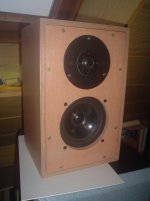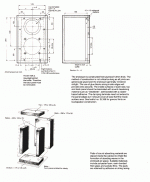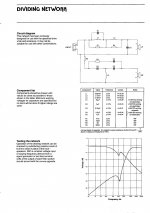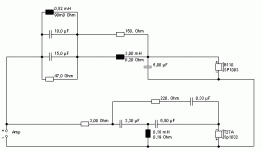I build the mini line interior within the specs and the outside of the cabinet with a sandfilled layer.
A very solid build. Midrange was ok, but the bass of the daline was more impressive and overall better balanced. The daline needs to be with the back against the wall.
Yes one can see how the Daline works as a transmission line speaker but in the case of the mini-line it is somewhat less clear.
The Atkinson SOTA has a very impressive deep TL-bass sound and the best midrange I have ever heard from the KEF B-110 driver. I reduced the SOTA to a 3 way system instead of the 5-way (with 6 drivers) Atkinson designd. I believed a 5-way system was over the top!
Looks wise. I suspect it would be difficult for a modern 1" tweeter placed above the 5" midrange not to be an improvement on the scattering of tweeters originally used in the design.
If you start with a ribbon for the top end and distributed subwoofers for the bottom end a 5 way can be a natural fit. A tweeter in a waveguide can drop it to a 4 way but it is hard to get just a 2 way to cover everything above 60-80Hz without significant compromises.Funny enough now I am building a complete 4-way active DSP controled system and I would like to have a 5-way system to cover the audio spectrum.
Here's the deal. I spent a couple years designing with the B110. I have *dozens* of quasi anechoic measurements of it in the JR149 and I spent months listening and tweaking with it. Its a brutal driver
- horrible break up, so bad you can see big glitches in the mid range impedance (thats rare!)
- off axis response that varies significantly with angle, compared to other drivers. It doesn't follow a nice predictable off axis roll with increasing angle. The break up is the culprit again, perhaps something going on in the spider as well
Similarly the T27 is a runt of a tweeter that's extremely easy to overdrive
My point is, these drivers can be made to sound enjoyably "old school" but they have really bad drawbacks that require experience and solid measurements to design around. They're not like modern drivers where you can get close-ish with a pre-canned xover designed for another application. The results will sound crappy.
If you can't measure and design your own xover, find a design using the B110 and T27 where the baffle width is similar to your target cabinet, and that has a sound you either know from personal experience you like, or that has a reputation you trust, and built that crosover. The reason baffle width matters is that it affects the lower mid/upper bass response and if you use an xover from a design with an appreciably different baffle width, the balance may sound off
Stick them in the box, put that xover on it, listen to it and report back.
The only way you'll better this is to measure the drivers in the target cab and design a new xover but nothing in this thread indicates that this is an available option
Everything else is noise and you're welcome
- horrible break up, so bad you can see big glitches in the mid range impedance (thats rare!)
- off axis response that varies significantly with angle, compared to other drivers. It doesn't follow a nice predictable off axis roll with increasing angle. The break up is the culprit again, perhaps something going on in the spider as well
Similarly the T27 is a runt of a tweeter that's extremely easy to overdrive
My point is, these drivers can be made to sound enjoyably "old school" but they have really bad drawbacks that require experience and solid measurements to design around. They're not like modern drivers where you can get close-ish with a pre-canned xover designed for another application. The results will sound crappy.
If you can't measure and design your own xover, find a design using the B110 and T27 where the baffle width is similar to your target cabinet, and that has a sound you either know from personal experience you like, or that has a reputation you trust, and built that crosover. The reason baffle width matters is that it affects the lower mid/upper bass response and if you use an xover from a design with an appreciably different baffle width, the balance may sound off
Stick them in the box, put that xover on it, listen to it and report back.
The only way you'll better this is to measure the drivers in the target cab and design a new xover but nothing in this thread indicates that this is an available option
Everything else is noise and you're welcome
the mini-line from its original publication but had trouble getting a reprint.
Quality limited by the scans i was given, but dimensions are readable....
http://www.t-linespeakers.org/download/WW-miniLine.pdf
dave
I might have known you'd have a copy 🙂
My scan was done by someone who has the complete run of HFN from the 50s on. Quality is about the same as yours.
My scan was done by someone who has the complete run of HFN from the 50s on. Quality is about the same as yours.
Reading all this, i am wondering what gave the B110 it's Cult status? Where there no reasonably well behaved papercone 5 inch midrange available at all at the time?
Paper cone drivers at the time could be unpredictable and vary during manufacture.
The Bextrene cone of the B110 - and Dalesford models, among others - was more reliable to manufacture. The B110 had a low resonance for its size and its parameters were a better balance for small enclosures. Increasing amplifier power meant that the lighter weight, higher sensitivity paper cones weren't such a requirement.
The cult status probably owes more to its place in the LS3/5a than anything.
The Bextrene cone of the B110 - and Dalesford models, among others - was more reliable to manufacture. The B110 had a low resonance for its size and its parameters were a better balance for small enclosures. Increasing amplifier power meant that the lighter weight, higher sensitivity paper cones weren't such a requirement.
The cult status probably owes more to its place in the LS3/5a than anything.
Despite all the damping going on in the cone, the Rms = 0.345 kg/s. Could be one of the factors. Always thought these were more like Volt or ATC drivers, damped until an inch of their life.
.....damped until an inch of their life.
I would argue damped beyond an inch. The 'dark' sounding result was part of their appeal, trifles like detail never getting in the way of an expensive and deep soundstage.
No offense taken! I agree with you completely, just adding the flaw may have been part of the driver's popularity. For its time.....
I wonder how close the new Falcon versions are - flaws and all? Reintroducing them seems an odd idea but it may have been the most direct route to a LS3/5A licence. Plus there are a LOT of those BBC speakers out there and many owners want a direct replacement when a driver craps out.
No,shurly not!Many thanks for that ertner - on topic - WOW!
Someone pointed me in the direction of the CS1A crossover earlier today and I am aware that Falcon Acoustics list the CS1 crossover but it seems to be for use with the B110 SP1057, should this work correctly my B110 SP1003?
Two years ago I have build my own CS1a, with B100A/T27 which I bought in 1982. See attachments for Crossover, Cabinetdetails and finished CS1a.
And don't give up. I am sattisfied with my CS1a and for some times I use a sub to improof bass.




Unfortunately, in real world this isn't even possible. No way to pushI was under the impression that thick and thin wall cabs solve the
inherent resonance problems in different ways but with hopefully
similar results.
Thin walls with heavy damping deal with the resonant frequency by
lowering it to below audible levels. Very much like correctly matching
tone arm mass with cartridge compliance when it comes to turntables.
Thick-walled stiff cabs on the other hand raise the resonances to
frequencies which are easier to kill by whatever other means.
lowering frequency below audible. Most of cabinet resonances usually
are in the midrange, say, some hundred Hz.
You're right with thicker walls raising frequency (cos stiffer) while at
the same time amplitude is reduced.
I'd consider if raising frequency above the mid-woofer's working range
is a worthwhile option.
Another approach is sand filling, which at the same time both reduces
sonic transmission and frequency, as it doesn't increase stiffness, but
mass.
Thin walls and heavy damping lower the resonance frequency only marginally, and even if that. Perhaps 10-50Hz, say down from 200Hz. But damping lowers the level of the resonance by several dB. I've experimented with 6mm of bitumen layer on a 20mm plywood enclosure and the main resonance of 120 Hz and 75dB at a specific test level was lowered to about 95Hz and 55dB.
20mm plywood? wow, pretty thick. I'd be interested in how much lower the resonance actually was, and I'd be very tempted to try with much thinner walls, say 5mm, with much heavier damping.
My theory is that it's not just the steady-state peaks that cause the "boxy" sound, but the length of time that the resonances continue to play after the exciting impulse has ended. Damping should help that a lot.
My theory is that it's not just the steady-state peaks that cause the "boxy" sound, but the length of time that the resonances continue to play after the exciting impulse has ended. Damping should help that a lot.
What bitumen layer material did you use for damping.Thin walls and heavy damping lower the resonance frequency only marginally, and even if that. Perhaps 10-50Hz, say down from 200Hz. But damping lowers the level of the resonance by several dB. I've experimented with 6mm of bitumen layer on a 20mm plywood enclosure and the main resonance of 120 Hz and 75dB at a specific test level was lowered to about 95Hz and 55dB.
Would something like Tetroseal or Hammerite Waxoyl car underseal work.
20mm plywood? wow, pretty thick. I'd be interested in how much lower the resonance actually was, and I'd be very tempted to try with much thinner walls, say 5mm, with much heavier damping.
My theory is that it's not just the steady-state peaks that cause the "boxy" sound, but the length of time that the resonances continue to play after the exciting impulse has ended. Damping should help that a lot.
You are right, trying to damp a thick and heavy wooden enclosure defeats the purpose. You need to start with something that can absorb less energy (less mass) so that damping material mass has a more pronounced effect to it.
I'm skeptical on views that a thin wooden enclosure will vibrate (even with damping material) as its lacking stiffness and that deteriorates transient responce. Once could brace the enclosure but that would move the resonance frequency higher (say make it twice if braced halfway up the height) which again defeats the original goal to keep the resonance frequency low in the spectrum and damp it.
The overall weight of the 180lt enclosure made of 20mm ply + 9mm bitumen became non practical to handle.
With much smaller enclosures, like the 5-10lt for an LS3/5a clone, I've built an 8lt enclosure made of 25mm ply and added 10mm of rubber sheets glued to the inner panels. Additionally the tweeter is placed about an inch behind the woofer (the front baffle has a step form, much like the KEF R105.1 mid/high heads) and that increases stiffness and rigidity. No need to brace it inside. And even the several layers of lacquer paint increase both stiffness and sealing of sound energy - complemented by rounded edges all round at about half an inch radius.
I built these back in the days when the B110 and T27 were current and still use them as computer speakers (in the nearfield as they should be used) using a modest amplifier. The desk helps boost the bass frequencies but they don't give out bass to blow your head off.
None of these concepts are really new. Worth going back to Linkwitz' article where he mounted a phono cart to monitor cabinet vibrations. .SB1980-3way
Unfortunately, in real world this isn't even possible. No way to push
lowering frequency below audible. Most of cabinet resonances usually
are in the midrange, say, some hundred Hz.
You should probably read the original BBC papers. They used 9mm ply and three layers of 3mm bitumen. It pushed the resonance to a lower frequency where their panel could not hear any significant problems. Bear in mind that their panel had access to live studio performances so were very capable at judging the results.
To add my two pennyworth to this, I have completed a long project building a pair of LS3/5as.
I know Jerry Bloomfied of Falcon. I knew about the new B110 and T27 before they were released on the market.
I wanted to build my LS3/5as as closely as possible to spec. so I sought advice from Jerry. Firstly the B110s I selected were early ones with the lead in wires showing through the cone, as utilised in early BBC versions of the 3/5 and 3/5a.
I tracked down a pair, and a speaker designer friend of mine measured the responses. A pair of NOS T27s were purchased.
Some may ask why I didn't go straight to Falcon Acoustics' new drivers. Basically I wanted to try and 'copy' early designs of the'3/5a.
The cabinets were ex. Harbeth LS35a ones, which required restoration. The front baffles, felt strips and other sundries came from Falcon or Stirling Broadcast.
Re. the crossover, I selected Falcon's new FL6/26 and Jerry built them up to the original spec.
Then the 'fun' began. The speakers were assembled and evaluated. Not just by me with recorded music, but live voices and monitoring recordings.
I have a small business, MGM Audio, and record in a small way as well as run a PA system.
My speaker designer friend advised on any crossover changes, etc.
After much listening we decided they were the best we could do. Remember we had listened to recordings which we could directly compare.
I haven't directly compared them to a pair of the new Falcon LS3/5a as Jerry seems to be selling every pair he makes !
What I have compared them to is live voices. That is the ultimate comparison for me.
As a sort of last word on the place of the LS3/5a in today's market, I will say that my Harbeth P3ESRs are superior loudspeakers as far as I am concerned but the LS3/5a is still a very strong contender
I know Jerry Bloomfied of Falcon. I knew about the new B110 and T27 before they were released on the market.
I wanted to build my LS3/5as as closely as possible to spec. so I sought advice from Jerry. Firstly the B110s I selected were early ones with the lead in wires showing through the cone, as utilised in early BBC versions of the 3/5 and 3/5a.
I tracked down a pair, and a speaker designer friend of mine measured the responses. A pair of NOS T27s were purchased.
Some may ask why I didn't go straight to Falcon Acoustics' new drivers. Basically I wanted to try and 'copy' early designs of the'3/5a.
The cabinets were ex. Harbeth LS35a ones, which required restoration. The front baffles, felt strips and other sundries came from Falcon or Stirling Broadcast.
Re. the crossover, I selected Falcon's new FL6/26 and Jerry built them up to the original spec.
Then the 'fun' began. The speakers were assembled and evaluated. Not just by me with recorded music, but live voices and monitoring recordings.
I have a small business, MGM Audio, and record in a small way as well as run a PA system.
My speaker designer friend advised on any crossover changes, etc.
After much listening we decided they were the best we could do. Remember we had listened to recordings which we could directly compare.
I haven't directly compared them to a pair of the new Falcon LS3/5a as Jerry seems to be selling every pair he makes !
What I have compared them to is live voices. That is the ultimate comparison for me.
As a sort of last word on the place of the LS3/5a in today's market, I will say that my Harbeth P3ESRs are superior loudspeakers as far as I am concerned but the LS3/5a is still a very strong contender
- Home
- Loudspeakers
- Multi-Way
- Can one build a better (non) LS3/5A speaker based on T27s & B110s?